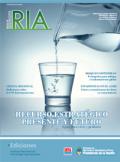Ver ítem
- xmlui.general.dspace_homeCentros e Institutos de InvestigaciónCIAP. Centro de Investigaciones AgropecuariasInstituto de Patología VegetalArtículos científicosxmlui.ArtifactBrowser.ItemViewer.trail
- Inicio
- Centros e Institutos de Investigación
- CIAP. Centro de Investigaciones Agropecuarias
- Instituto de Patología Vegetal
- Artículos científicos
- Ver ítem
Comportamiento de diferentes cultivares de trigo a Wheat streak mosaic virus (WSMV) y High Plains virus (HPV) mediante infección artificial con el vector Aceria tosichella Keifer, bajo condiciones de campo
Resumen
El trigo (Triticum aestivum L.) es el cereal de invierno de mayor importancia económica en la Argentina. Dado que Wheat Streak Mosaic virus (WSMV) y High Plains virus (HPV) constituyen una de las principales limitantes sanitarias del cultivo de trigo, el objetivo del presente trabajo fue evaluar el comportamiento de diferentes cultivares ante ambas enfermedades en infecciones artificiales, bajo condiciones de campo. El inóculo viral mixto WSMV-HPV y el
[ver mas...]
El trigo (Triticum aestivum L.) es el cereal de invierno de mayor importancia económica en la Argentina. Dado que Wheat Streak Mosaic virus (WSMV) y High Plains virus (HPV) constituyen una de las principales limitantes sanitarias del cultivo de trigo, el objetivo del presente trabajo fue evaluar el comportamiento de diferentes cultivares ante ambas enfermedades en infecciones artificiales, bajo condiciones de campo. El inóculo viral mixto WSMV-HPV y el vector A. tosichella se obtuvieron en campo y se multiplicaron en laboratorio. Los eriófidos infectados con ambos virus se utilizaron para realizar las infecciones en campo. Se evaluó la incidencia, el grado de infección y la severidad de síntomas de las infecciones en los diferentes genotipos de trigo. Los cultivares fueron clasificados según la probabilidad de incidencia de cada virus y su interacción, hallándose diferencias significativas sólo en los casos de infecciones con HPV. No se hallaron diferencias significativas en el comportamiento de los cultivares al WSMV. Sólo el 9,2% de los cultivares estudiados presentó infección de ambas virosis. El grado de severidad observado varió entre leve a moderado para las plantas que
resultaron infectadas. Los resultados reportados en el presente trabajo constituyen una herramienta potencial para la selección de genotipos con mejor comportamiento en este contexto productivo
[Cerrar]
Wheat (Triticum aestivum L.) is the most economically important winter cereal in Argentina. Its production is limited by several factors, including viral diseases. Since Wheat streak mosaic virus (WSMV) and High Plains
virus (HPV) are one of the main limitations in wheat production, the aim of this study was to evaluate the behavior of different wheat genotypes in artificial infections with both pathogens under field conditions. HPV-WSMV
mixed inoculums
[ver mas...]
Wheat (Triticum aestivum L.) is the most economically important winter cereal in Argentina. Its production is limited by several factors, including viral diseases. Since Wheat streak mosaic virus (WSMV) and High Plains
virus (HPV) are one of the main limitations in wheat production, the aim of this study was to evaluate the behavior of different wheat genotypes in artificial infections with both pathogens under field conditions. HPV-WSMV
mixed inoculums and the vector Aceria tosichella were obtained from field sampling and multiplied in wheat under laboratory conditions. These HPV-WSMV infected eriophyid were used to perform artificial infections in the field. Incidence and symptoms severity levels were evaluated in different wheat cultivars. Genotypes were
classified by the probability of incidence of both viruses showing significant differences only in infections with HPV. No significant differences were found in the susceptibility of cultivars to WSMV. Mixed infections were observed only in 9.2 % of wheat genotypes analyzed. Mild to moderate symptoms were shown by infected plants. These results are a potential tool for the selection of best performing genotypes in this productive context.
[Cerrar]

Fuente
RIA, 39 (1) : 67-76
Fecha
2013-04
Editorial
Gerencia de Comunicación e Imagen Institucional, DNA SICC, INTA
ISSN
1669-2314
Formato
pdf
Tipo de documento
article
Palabras Claves
Derechos de acceso
Abierto
 Excepto donde se diga explicitamente, este item se publica bajo la siguiente descripción: Creative Commons Attribution-NonCommercial-ShareAlike 2.5 Unported (CC BY-NC-SA 2.5)
Excepto donde se diga explicitamente, este item se publica bajo la siguiente descripción: Creative Commons Attribution-NonCommercial-ShareAlike 2.5 Unported (CC BY-NC-SA 2.5)


